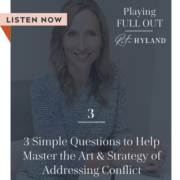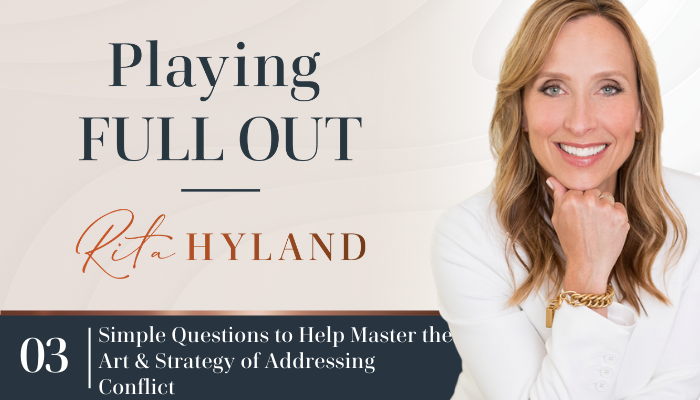The Simple Step-by-Step Candid Conversation Formula

Listen to the full podcast episode to learn a simple 7-part formula to address and resolve conflict in any relationship (whether in the boardroom or bedroom) so that you can clear your issues, resolve conflict and actually improve your relationships by addressing the unspoken and uncomfortable.
What percentage of people do you think have been taught a simple process for conflict resolution, considering that conflict is inevitable in every relationship both personal and professional? The answer is so low that researchers have likely never thought it worthy enough to measure.
When it comes to conflict, it’s not if it will happen, but when. While we do not want it, it’s key for the sake of our relationships and leadership that we get good at addressing and resolving it.
That’s why today I’m going to walk you through a reliable 7-step formula that you can use any time you’re having an issue that needs to be cleared. Using this approach you will feel more confident leaning into even your most difficult or charged conversation. It will also ensure that you are heard, that you care, and that you resolve issues healthily and quickly.
Before we step into this process, it’s important to establish a strong foundation for the candid conversation. Here are 3 steps you can take before you begin:
-
Set the intention.
- It’s important to approach any candid conversation with the intention to support, to love, and to provide what needs to be said. While engaging in a conversation to clear your issues, don’t come to it unprepared or in a less than positive state. Know what it is you want by the end of the conversation.
-
Be sure to mention what is working.
- You can do this by saying, “This is the 90% that is working really well. Now let’s talk today about the 10% that will take us to the next level.”
-
Honor the other person by being vulnerable.
- Vulnerability shows the other person that you care, that you see each other as equals, and that you value the other in the experience. You can do this by saying, “I am committed to your success and being in this conversation until we get to a good place for both of us.”
-
Let the other person know that you want the real deal.
- You can do this by saying, “I’m going to be transparent with you. I want you to be transparent with me. If you don’t understand or agree with something, I want you to tell me that.”
One of the biggest problems when we attempt to engage in healthy conflict, is that we tend to come to the conversation with facts, interpretations, stories, judgments, feelings, and wants that get entangled. As a result, often little is heard, issues go unresolved, and things are left even messier than they were before.
One of the key elements of this 7-step formula to candid conversations is to discern and identify each part for what it is. The steps include:
- Affirm the importance of the relationship. Set the stage and affirm that the other person is important to you. For example: “Our relationship is important to me and I want to discuss something that’s affecting it.”
- Set the intention. This is just a little bit different than our foundational step above. Here you want to articulate your intention making sure to be clear so if the conversation gets off track, you can use your intention to get back on track. For example: “My intention for this conversation is that our relationship is stronger as a result of us talking.” Or “My intention for this conversation is to be clear about what is expected of you when you come to our leadership meeting.”
- State the facts. This is where things can begin to get messy. In this part of the conversation it is important to state only the facts. Be very clear about what happened without any added judgments or stories. For example: “Less than 50% of the team came prepared with the answers to the questions that were laid out 2 to 4 weeks ago.” Or “You came in 15 minutes past curfew.”
- Offer your interpretations. This is where you can begin to share your interpretations and what you are concerned about. For example: “I interpret the facts to mean…”, “I’m concerned because to me this means…”, or “The story I tell myself when this happens is…” and then fill in the rest. That may sound like: “You’ve been gone for three out of the last four weekends. I interpret that to mean that you’re not concerned with investing time in our marriage.”
- Clarify your feelings. This may sound like: “When I believe this, I feel disrespected, I feel unheard, I feel unseen.”
- Own your level of responsibility. I am a big believer that each of us is 100% responsible for 50% of the relationship, and we have to own our half. For example: “My role in this is…” or “My part in allowing or enabling this issue is…” If we’re speaking to a child that’s missed curfew, it could sound like this: “My part in this is that I have allowed you to be late before and not held you accountable. That may be confusing.”
- Articulate what you want and ask for it. Be clear and specific in your request focusing on the positive. This is a part where it can be very easy to focus on what you don’t want, like “I don’t want you coming in late,” or “I don’t want you coming to team meetings unprepared.” It’s much more important and effective to speak to what you do want because the subconscious brain doesn’t hear words like “don’t” and “no.” Paint a vivid picture of the ultimate ideal future as it pertains to this issue. For example: “I’d like you to arrive at the meetings 10 minutes early. At that time, we can address each other, enjoy each other, and proceed with our intended agenda.”
If you want to effectively address and resolve issues in your relationships, it’s essential to communicate in a way that your concerns are heard, that is not overridden with judgment, that sees others as equal, and expresses your feelings and interpretations of the situation.
Once you’ve effectively and clearly communicated, you can move forward by listening and hearing the other person with responses like, “Tell me what it is you’re hearing,” or “Tell me what it is you’re taking from this conversation.” You will also want to get the other person’s commitment to take the steps you identified along with other ideas they might have.
Having a method to resolve issues allows you to feel more confident heading into an issues clearing conversation and more likely to lean in instead of step over it.
Remember that being transparent is kind. When you use this formula to have a candid conversation with the purpose of clearing issues, you will see your productivity, peace of mind, and quality of relationships dramatically improve.
Your call to action is to challenge yourself this week to step over nothing. Instead, address what isn’t being said. Talk about issues before they get so large that they can’t be disarmed or dispelled. First, lay your foundation and then use the simple step-by-step formula.
As reassurance, know that if these issues are on your mind, they’re probably on the other person’s mind too. You’ll both be served by clearing the air and acknowledging the elephant in the room.
In this episode I share:
- 3 foundation-building steps to set your candid conversation up for success
- A step-by-step formula to engage in difficult conversations whether personal or professional
- Examples of the exact words in the right order that will help you to resolve even the most difficult conflicts in the boardroom, office, or at home
Resources and related episodes:
- If you’d like to be notified of when new podcast episodes are released, you can do so here: Playing Full Out
- Learn more about the Inside Out Method
- Connect with Rita on LinkedIn.
Subscribe on Apple Podcasts for more tips, tools, and inspiration to leading the optimal vision of your life, love, and leadership. Remember, a half version of you is not enough. The world needs the fullest version of you at play.
___
About Rita Hyland
With over 20 years of experience as an executive and leadership coach, Rita helps leaders — emerging and established — excel in corporate and entrepreneurial environments.
Rita believes if leaders were more clear about how transformation really works and more intentional about creating what they want, their impact, success, and influence in the world would be unstoppable.
Through her coaching programs, private coaching, and masterminds, Rita shows leaders how to win consistently and create the impact and legacy they desire.
Central to Rita’s work is the understanding that you will never outperform your current programming, no matter how strong your willpower.
When you learn to use Rita’s proprietary Neuroleadership Growth Code, a technology which uses the best of neuroscience and transformational psychology to hit the brain’s buttons for change, YOU become both the solution and the strategy.
Her mission is to end talented, hard-working, and self-aware leaders spending another day stuck in self-doubt or confusion and not contributing their brilliant work and talent the world so desperately needs.





